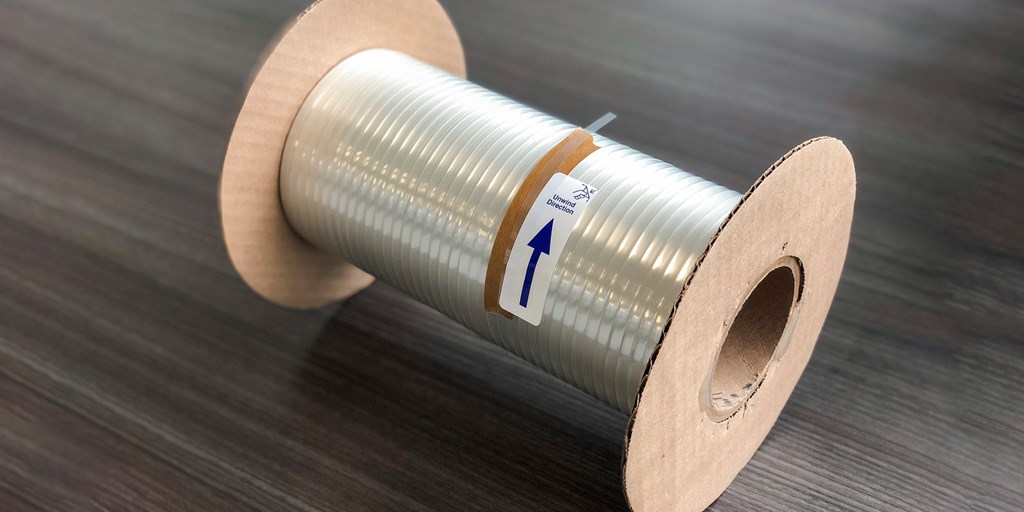What Exactly is Traverse Winding?
In the shrink tape industry, tape is traditionally wound in a single direction around a core (which itself is a sliced portion of a tube or spool that matches the desired tape width), creating the standard roll of tape we’re all familiar with. However, companies with high-throughput production environments may have a need for longer, continuous lengths of shrink tape — much like wire and other materials. This is where traverse winding comes into play.
With traverse winding, the material is wound laterally around a spool or core. The winding mechanism moves from side to side, evenly distributing the material onto the spool in multiple layers until the desired amount or length has been wound. This process requires absolute precision so the appropriate tension is applied and the tape is wound properly around the spool.
A key difference with traverse winding when it comes to shrink tape is that the winding mechanism can’t move side to side. Whereas other tension-wound materials are wrapped around a stationary spool by the device moving side to side, traverse-wound tapes instead have the spool move under the fixed input of the material.
This is because flat materials like shrink tape require consistent lay to avoid imperfections. If the winding mechanism moved from side to side, the tape might stretch on different sides, resulting in deformities that will impact the product when the tape is applied.
What Are the Advantages of Traverse Winding?
In high-throughput environments, consistent production is an absolute to meet and exceed goals. Workers don’t have time to manually apply shrink tape to larger products, and because shrink tape typically comes on cores, workers would have to deal with numerous rolls — adding to the time needed to complete a lay-up.
With traverse winding, shrink tape can be ordered on a spool with longer and continuous lengths. This makes application vastly more efficient as it doesn’t require workers to change out the material as frequently, and because the tape can be applied to products for longer periods and even with greater consistency. Tape can still be applied by hand if needed, but the advantage of not having to change out the spool as frequently still stands.
Dunstone Offers Multiple Shrink Tape Solutions
While materials such as cellophane, nylon, and polypropylene provide compression only during the process of application under tension, during cure cycles they lose compression strength as the temperature rises. This phase is critical to the resulting quality of the resin, and less-than-ideal performance can result in voids or inconsistencies in the layup.
With our Hi-Shrink Tape, compression begins at 70ºC (158ºF) and reaches maximum force at 120ºC to 180ºC (248ºF to 356ºF; higher temperatures up to 400ºC are available). This ensures that as the temperature rises, our tapes’ pressures increase as the resin cures — resulting in a cured resin that’s free from voids and surface defects.
Our shrink tapes are available in a variety of thicknesses to ensure you have the right amount of compressive force for your application. Thicknesses ranging from .001” (1 mil) to .005” (5 mils) are available with shrink percentages ranging from 5% to 20% and max shrink force at peak temperatures ranging from 1.65 up to 21.64 pounds of pressure.
Many of our shrink tapes are also available with release coatings, which are designed for applications in which the tape needs to be removed after the composite material has finished curing. This makes removing the tape simple and also helps to move excess resin away from the composite during the curing cycle. Many of our release-coated shrink tapes are available with 1- or 2-sided coatings.
In many applications, composite layups and wet-winds produce volatiles like gasses and vapors that must be allowed to escape from the matrix. If not, they’ll create bubbles and other issues or prevent the matrix layers from bonding. To solve this, our 200 Series shrink tapes are available in perforated versions that allow these volatiles to escape (also called outgassing).
That’s a Wrap — Now Experience the Difference Firsthand
Whether you need a quick-and-easy solution for minor compressive force or an extremely high-temperature tape, our team is here to help. Many of our tapes can be prepared via traverse winding, ensuring you have the sufficient length of material needed and are in a strong position to maintain your high-throughput workflow and achieve productivity goals.
